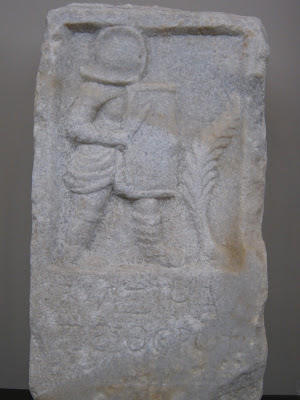Our morning began at Mieza where Charles gave his report on Aristotle's School. We sat on stones upon which perhaps Aristotle himself once sat and trekked through woods that perhaps a young Alexander and a young Hephaistion once trekked! There's not much left now, but one can still climb ancient stone steps into one of the three caves.
Next we visited some locked sheds and garages which protect some very well-preserved Macedonian tombs. We were allowed to take pictures but were asked not to post them on the Internet, so I can't share any here. They were monumental like the tombs in the Vergina museum and a surprising amount of paint survived on the exteriors. We also got to look inside one and there was some colorful painting on its interior.
Our next stop was Pella which, for you Iowa folks, is not the namesake of Wyatt Earp's hometown of the same name in Iowa. No tulips there, either, but there was a museum with mosaics and other finds, including lead curse tablets(!), excavated from the ancient town. Angele gave her report on mosaics, like the one below which is believed to be Alexander and a friend hunting a lion.
At the actual site of Pella, Flint talked about the urban plan and the "House of Dionysus," so named because of the large mosaic of Dionysus riding a panther found on the floor of one of the rooms. The mosaic has been moved to the museum where I tried to get a good picture but couldn't.
Our next stop was Thessaloniki where we went to the archaeological museum. First we heard John's report on the Derveni Krater, a large wine vessel found in a Macedonian tomb.
I never could get a good picture so I'm using this one from wikipedia. The date assigned to this krater can help determine the date of the tomb.
Next, we went over to the Roman section of the museum to hear Joni's report on the Via Egnatia. Sadly, the milestone we had hoped to see was on loan to another museum. Afterward, we wandered around the museum. Tristan, I took these pictures of gladiator sculptures for you!
Next we visited some locked sheds and garages which protect some very well-preserved Macedonian tombs. We were allowed to take pictures but were asked not to post them on the Internet, so I can't share any here. They were monumental like the tombs in the Vergina museum and a surprising amount of paint survived on the exteriors. We also got to look inside one and there was some colorful painting on its interior.
Our next stop was Pella which, for you Iowa folks, is not the namesake of Wyatt Earp's hometown of the same name in Iowa. No tulips there, either, but there was a museum with mosaics and other finds, including lead curse tablets(!), excavated from the ancient town. Angele gave her report on mosaics, like the one below which is believed to be Alexander and a friend hunting a lion.
At the actual site of Pella, Flint talked about the urban plan and the "House of Dionysus," so named because of the large mosaic of Dionysus riding a panther found on the floor of one of the rooms. The mosaic has been moved to the museum where I tried to get a good picture but couldn't.
Our next stop was Thessaloniki where we went to the archaeological museum. First we heard John's report on the Derveni Krater, a large wine vessel found in a Macedonian tomb.
| Picture by Michael Greenhalgh from Wikipedia |
Next, we went over to the Roman section of the museum to hear Joni's report on the Via Egnatia. Sadly, the milestone we had hoped to see was on loan to another museum. Afterward, we wandered around the museum. Tristan, I took these pictures of gladiator sculptures for you!








The mosaics are gorgeous.
ReplyDelete